| Leaf Springs Tech | ||||||||||||||||
|
Even though
it is the oldest type of automotive suspension, leaf
springs continue to be a popular suspension choice among racers.
Though simple in appearance, a
leaf spring suspension involves many intricacies understood by
few racers. The following information should help you to better understand
and consequently, better tune a leaf
spring suspension. The information applies only to unsymmetrical
leaf
springs with shackles
mounted above the leafs (typical of most race cars), unless noted
differently. For instance, the axle mount deadens part of the leaf and an increase in spring rate results. The increase is proportional to the amount of spring that is deadened by the mount. You can expect an increase in spring rate after replacing "factory type" rubber lined axle mounts (which deaden relatively little of the leaf) with solid axle mounts and lower plates. Any lengthwise twisting of a leaf spring will also cause an increase in spring rate. The increase is proportional to the degree of the twist. The twist results from stagger, wedge, bent axle tubes, misaligned chassis mounts, etc. that cause the axle mount and spring to be at an angle to each other from a rear view.( see illus. 1) The leaf twists whenever it is tightened flat to the unparallel axle mount.
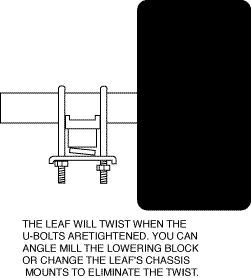 You can eliminate any static leaf spring twist by shimming or angle milling the axle mount or lowering block, or by angling the leaf and shackle frame mounts. However, twist will still develop as soon as the chassis begins to roll! Leaf twist is more pronounced with solid type leaf eye bushings than with the more pliable rubber bushings. Practically all potential for twisting a leaf spring is eliminated by using an AFCO front eye pivot instead of a bushing. Your leaf will become softer as twist in the leaf is reduced. At the least, you should eliminate any static twist present in your leaf springs whenever your chassis is at ride height. Otherwise, you may unknowingly change rear spring rate whenever you replace or adjust rear suspension components. A static tension in the leafs is present whenever the leafs and axle mounts are not parallel from a side view(see illus. 2). Any static tension will cause an increase in spring rate. You can check for this tension by placing jack stands under both leaf springs directly below the axle and then unbolting one side of the axle from its leaf (use this same procedure on both leafs to check for lengthwise twist). The axle mount should seat evenly to the leaf as viewed from the side. If necessary, reposition the axle clamp on the axle tube to eliminate any twist. AFCO clamp-on axle brackets will facilitate corrections. Illustration 2. 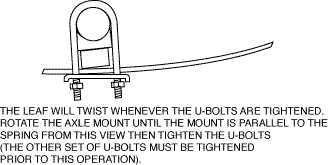
SHACKLES
The angle of the shackle can stiffen or soften a spring's normal rate. You can determine the effective angle of a shackle by drawing a line through the middle of both spring eyes and a line through the shackle pivots. Then measure the angle formed by the two lines (measure ahead of the shackle - see illus. 3). You can increase the effective rate of a leaf spring by decreasing the shackle angle. An increase in shackle angle will produce a decrease in the effective leaf spring rate of a leaf spring.
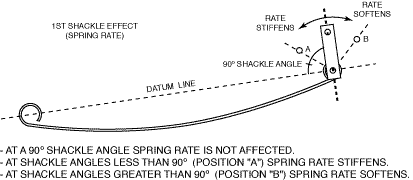 A good starting point for shackle angle is 90 degrees. In this position the shackle has no effect on spring rate. Keep in mind that the shackle angle changes (and consequently the spring's effective rate changes) whenever the suspension moves. Also, the shackle's angle will change whenever you change the chassis' ride height, the arch of the leaf, the load on the leaf, or the length of the shackle. Since the shackle direction changes when the leaf is deflected past a flat condition, you should avoid deflecting the right rear leaf to an extremely negative arch condition. This could cause a very large shackle angle at high loads and consequently a very soft spring rate. Excessive body roll and poor handling could result. You can correct this problem by decreasing the shackle angle, increasing the arch, of the spring by increasing the rate of the right rear leaf spring. Shackle length is another factor affecting the rate of a leaf spring. A short shackle will change its angle (and the effective rate of the leaf spring) quicker than a long shackle upon deflection of the leaf. There is a second shackle effect on the stiffness of the rear suspension that counteracts and sometimes exceeds the shackle�s effect on spring rate. This second effect occurs whenever the shackle swings in its arc and moves the rear spring eye vertically.(see illus. 4)
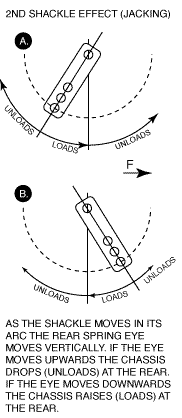 The vertical movement of the rear spring eye causes a jacking effect. If the shackle movement forces the rear spring eye downward, the leaf will deflect and exert an upward force on the chassis that will add stiffness to the rear suspension. Conversely, the shackle will reduce suspension stiffness if t causes the rear spring eye to move upward during suspension travel. The stiffening effect occurs during suspension deflection whenever the rear spring eye is ahead of the upper shackle pivot and the shackle is moving rearward (see illus. 4, example B). In this position, however, the shackle also produces a softening effect by reducing the effective rate of the leaf spring (due to the large shackle angle). The overall effect to the stiffness of the rear suspension is determined by the greater of the two shackle effects. Under opposite conditions, you can expect a reversal to the above effects. If the rear spring eye is located behind the shackle pivot (illus. 4 example A) the shackle effect will tend to reduce suspension stiffness whenever the shackle moves rearward. However, the small shackle angle will tend to stiffen the spring's rate. The overall effect to the suspension's stiffness is determined by the more dominant of the two shackle effects. Keep in mind that the movement of the rear spring eye (from its static position) is mostly forward under racing conditions. If a leaf goes into negative arch the travel direction of the shackle changes and the shackle effects change. Handling is not consistent under these conditions. The second effect of the shackle can be enhanced by increasing the length of the shackle. Generally, the second shackle effect (jacking)is dominant. SLIDERS The AFCO leaf spring sliders (SEE PHOTO) can eliminate the up and down movement of the rear spring eye caused by shackles moving through their arcs during suspension travel. Consequently, the rear suspension's loading points displace less during suspension movement. Sliders, depending on their installed angle, generally reduce the shackle effect� and provide more consistent spring rates than shackles. There is no shackle effect to the rate of the spring when the slider is mounted to point directly at the front spring eye center(this is the preferred mounting position). Since sliders are usually more rigid than shackles, they have less tendency to bind laterally during cornering. In general, sliders improve the handling consistency and predictability of leaf spring equipped race cars. ROLL CENTER HEIGHT The rear roll center is the point around which the back of the chassis rolls. Generally, raising the rear roll center tends to loosen handling. A lowered rear roll center tends to tighten handling. The lateral location of the rear roll center is difficult to determine and not necessary to this article. However, you should know how the height of the roll center is affected by the mounting position of the leafs. (see illus. 5)
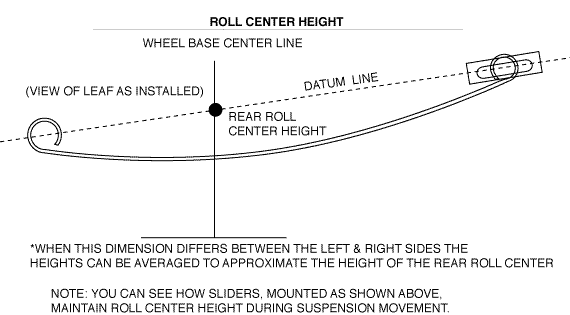
ARCH
The free arch of a leaf spring is correctly measured by drawing a line (datum line�) through each leaf eye center and then measuring (perpendicular) from the datum line to the spring surface at the centering pin. The spring should be lying on its side in the free state whenever it is measured. When experimenting with different arches you can expect the following effects on handling.
B. You can expect handling changes opposite to the above when using leafs with less arch. LEAF MOUNTING ANGLES The geometry of a leaf spring suspension appears to provide the best overall handling whenever the front leaf eye is mounted below the rear eye. If you lower the front eye of the leaf 1" or more and readjust the chassis back to its original ride height, you can expect the following: You can expect results opposite to the above when you raise the front eye of the leaf and adjust the chassis back to its original ride height. Mounting the leafs so that the front eyes are slightly inboard of the rear eyes will cause the leafs to have more lateral stiffness. This can make the chassis feel tighter and may help prevent the rear suspension from binding due to excessive lateral deflection of the leaf. However, if the leafs are offset too much, the suspension becomes too stiff laterally and rear side bite is lost. Whenever the body slides� over the rear end during cornering, the splayed leafs can cause rear steer that will help the car to turn. Also, if the right front spring eye is mounted more inboard than the left eye (measured from the corresponding tires), the right rear tire will tend to be loaded less than the left rear tire during acceleration. As a result, the chassis will tend to be tighter off the corner. Corner exit handling tends to be loose under opposite conditions Generally, moving the front spring eye 1 1/2" laterally will produce a noticeable effect to corner exit handling. LOWERING BLOCKS Lowering blocks are generally used to change the ride height of the chassis. Lowering blocks can also be used to adjust wedge when multi-leafs are used. The addition of lowering blocks can cause less tight� roll steer which will help the chassis to turn. If lowering blocks drop either or both spring eye positions relative to the axle then the rear roll center height will be lowered and chassis roll, along with rear side bite, will increase. Too much lowering block* can cause the forward thrust of the rear axle to prevent the leafs (or torque arm) from wrapping up and absorbing engine torque. Consequently, forward bite is diminished. A symptom of this problem shows up on torque arm equipped cars as very little 5th coil/shock movement. *The distance between the bottom of the axle tube and the top of the leaf should not exceed 4 1/2". What to look for in a quality leaf spring: 1. Smooth, continuous and consistent arch 2. No lengthwise twist 3. High strength steel 4. Heat treated 5. Tension side of leaf shot-peened for increased durability (produces a satin smooth finish) 6. Rubbing blocks between secondary leafs 7. Secondary leafs taper cut at ends. 8. Proper eye alignment (front and rear eyes should be parallel in all directions).
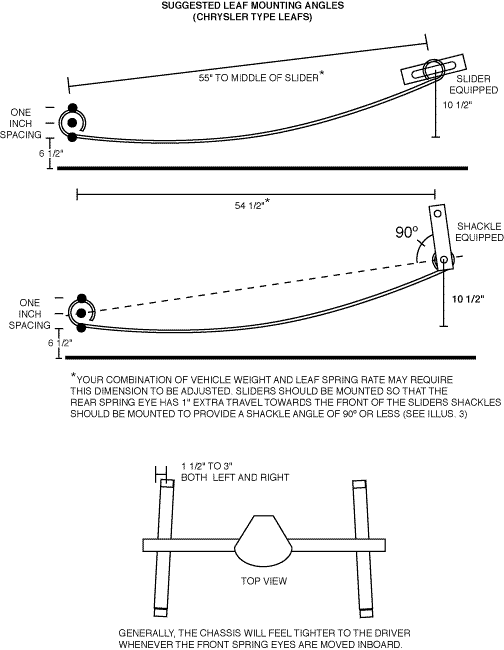 Remember, the many factors of a leaf spring suspension are interrelated and a change to one aspect of the suspension usually affects others. Consequently, the handling results are not always as predicted! Hopefully this text will provide you with the understanding necessary to correctly analyze handling and adjust your leaf spring suspension correctly. | ||||||||||||||||